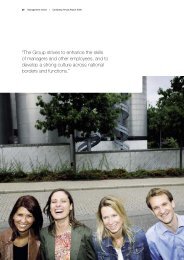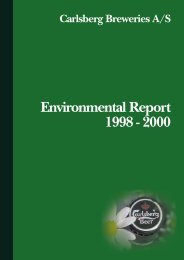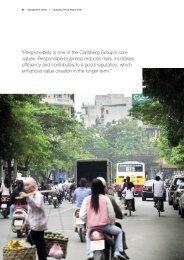Annual Report 2001 - Carlsberg Group
Annual Report 2001 - Carlsberg Group
Annual Report 2001 - Carlsberg Group
Create successful ePaper yourself
Turn your PDF publications into a flip-book with our unique Google optimized e-Paper software.
72 Financial Review of the <strong>Carlsberg</strong> <strong>Group</strong><br />
Cash flow<br />
The cash flow statement gives a complete<br />
overview of the origin and application of the cash<br />
flow throughout the year.<br />
Cash flow from the operations of the <strong>Group</strong>,<br />
inclusive of financials but exclusive of changes in<br />
the working capital, amounted to DKK 3.8bn<br />
against DKK 3.0bn last year (15 months). Total<br />
cash flow from operations amounted to DKK<br />
2.2bn against DKK 2.3bn last year (15 months),<br />
which is a considerable improvement when taking<br />
into account the accounting period.<br />
The <strong>Group</strong> has sold securities, resulting in a<br />
positive net contribution of DKK 0.8bn. This revenue<br />
has been applied to reduce short-term debt<br />
to credit institutions. Increased tied-up working<br />
capital amounted to DKK 1.6bn.<br />
DKK 3.6bn was applied for the purchase of<br />
tangible fixed assets and net DKK 2.0bn for the<br />
acquisition of companies, etc.<br />
Free cash flow amounted to a negative DKK<br />
1.3bn against a negative DKK 3.8bn last year.<br />
When taking the <strong>Group</strong>’s increase in debt into<br />
consideration, a total positive cash flow of DKK<br />
1.0bn appears for the financial year.<br />
In aggregate, cash at bank and in hand of the<br />
<strong>Group</strong> amounted to DKK 3.2bn at 31 December<br />
<strong>2001</strong>.<br />
Securities, cash and cash equivalents and<br />
interest-bearing debt<br />
At 31 December <strong>2001</strong>, securities, cash and cash<br />
equivalents, consisting of cash at bank and in<br />
hand and listed securities, amounted to DKK<br />
3.3bn (2000: DKK 2.9bn) based on official stock<br />
exchange prices. Furthermore, confirmed but<br />
unutilised credit facilities amounted to about DKK<br />
4.4bn (2000: DKK 3.4bn).<br />
The net interest-bearing debt totalled DKK<br />
10.9bn which is an increase of about DKK 0.6bn.<br />
This is a natural consequence of the investments<br />
described above.<br />
The <strong>Group</strong>’s loan portfolio consists of listed<br />
bond loans, bilateral loan agreements and syndicated<br />
credit facilities, primarily raised in currencies<br />
in which the <strong>Group</strong> holds assets.<br />
Financial risks<br />
As an international business the <strong>Carlsberg</strong> <strong>Group</strong><br />
is exposed to a number of financial risks, primarily<br />
through <strong>Carlsberg</strong> Breweries A/S. Financial risks<br />
and management and planning of liquidity are<br />
managed centrally, including funding and placement<br />
of excess liquidity. The use of financial<br />
instruments is regulated by instructions approved<br />
by the Board of Directors and by internal procedures.<br />
The instructions and procedures specify the<br />
types of financial instruments allowed, counterparties<br />
and risk limits.<br />
Exchange rate risks<br />
By far the predominant part of turnover originates<br />
from foreign companies translating into Danish<br />
kroner according to computed average exchange<br />
rates. Fluctuations in these currencies against the<br />
Danish krone will have a direct impact on the<br />
Company’s profit and loss account. The<br />
company’s exchange rate exposure is distributed<br />
on many countries outside Denmark. <strong>Carlsberg</strong><br />
Breweries’ exchange rate exposure is primarily<br />
related to EURO, GBP, CHF and RUR.<br />
Compared to previous years, the Danish krone<br />
accounts for a significantly smaller part of earnings.<br />
This is mainly attributable to the addition of<br />
Orkla’s beverage activities, of which BBH in particular<br />
accounts for a substantial part of earnings<br />
(30%).<br />
In the balance sheet, fluctuations in exchange<br />
rates affect primarily the translation of the foreign<br />
companies’ equity at the exchange rate ruling at<br />
the balance sheet date. Adjustment is made directly<br />
against equity as is also the case with longterm<br />
loans in foreign currencies raised to hedge<br />
investments in subsidiaries.


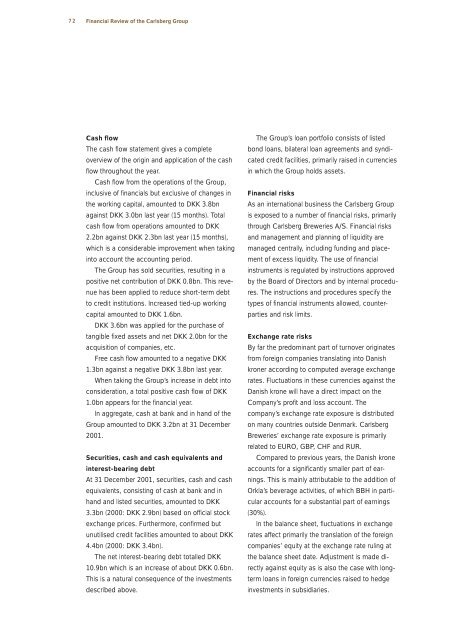
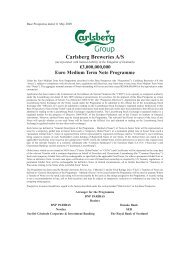
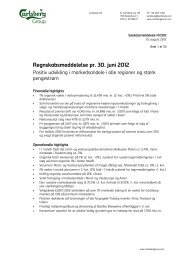

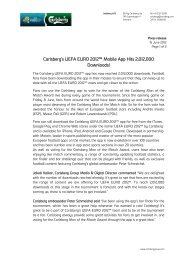
![[Name and Address] - Carlsberg Group](https://img.yumpu.com/49766377/1/184x260/name-and-address-carlsberg-group.jpg?quality=85)

![[Name and Address] - Carlsberg Group](https://img.yumpu.com/49015962/1/184x260/name-and-address-carlsberg-group.jpg?quality=85)
